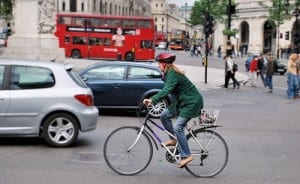Cycling, walking or driving – what are the risks and benefits?
By news editor, on 12 February 2013
![]() Written by Rosemary Willatt, UCL Sustainability Stakeholder and Communications Coordinator.
Written by Rosemary Willatt, UCL Sustainability Stakeholder and Communications Coordinator.
Is cycling really that dangerous compared to walking or going by car? Are the health benefits really worth the risk of death or serious injury?
On 28 January, as part of UCL’s Environmental Sustainability Topic Lunch Series, Dr Jenny Mindell presented on the risks associated with three modes of transport – cycling, walking and driving.
Dr Mindell started by covering both the health benefits of physical activity and negative effects of inactivity. She presented several studies where cyclists had better health than others using metrics such as mortality rates, explosive muscle power and aerobic fitness. She also explained that air quality is lowest inside cars.
This all sounded very positive for cycling, but what about all the cycling injuries reported in the news? Dr Mindell commented that these accidents have high visibility, whereas there is low visibility of inactive patients and those who are healthy because they are active.
She emphasised that inconsistencies in the datasets used for comparison may also cause cycling to appear more dangerous than it really is.
Looking at London, there was a 91% increase in the number of people cycling between 2000 and 2009 but a 33% reduction in cycling deaths and serious injuries.
This brought up the question of safety in numbers – these data would suggest that it’s safer to cycle if more people do, but we don’t know how the trend would change with a further increase in numbers.
So what are the risks associated with cycling? Department for Transport [i] statistics show that the risk of collision leading to hospital admission is one per 2,000,000km cycled and the risk of death is one per 3,000,000km cycled. If you cycle 1,500km per year that’s one fatality every 20,000 years.
Dr Mindell presented several results from her PLOS One article, but for me the headlines were these: in terms of on-highway fatalities, cyclists and pedestrians were equally at risk and both around an order of magnitude higher than drivers; females were also less at risk than males.
The most striking figure for me was that 17 to 20 year-old males were nearly five times more at risk while driving than cycling, implying that it would be safer for everyone if this group cycled rather than drove. This is an area for future research.
This presentation was part of the Environmental Sustainability Topic Lunch Series – for links to Dr Mindell’s presentation and PLOS One article please see the Green UCL website.
[i] Department for Transport. Pedal cyclist casualties in reported road accidents: 2008. London: DfT, 2010.
One Response to “Cycling, walking or driving – what are the risks and benefits?”
- 1
 Close
Close



UCL/TfL are offering free cycle training as part of the cycle safety ambassador programme – for more information see http://www.ucl.ac.uk/greenucl/whats-happening/programmes/tfl-cycle-safety-ambassador-scheme